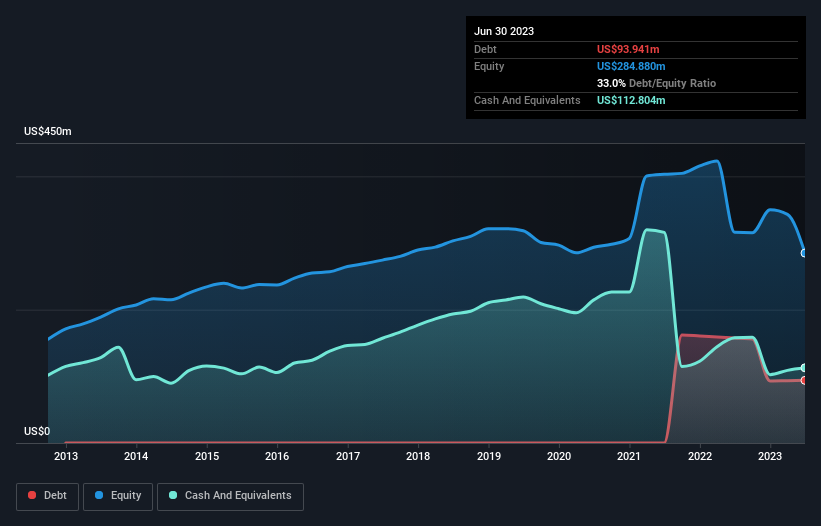- United States
- /
- Consumer Services
- /
- NasdaqGS:APEI
Is American Public Education (NASDAQ:APEI) Weighed On By Its Debt Load?
Howard Marks put it nicely when he said that, rather than worrying about share price volatility, 'The possibility of permanent loss is the risk I worry about... and every practical investor I know worries about.' When we think about how risky a company is, we always like to look at its use of debt, since debt overload can lead to ruin. We note that American Public Education, Inc. (NASDAQ:APEI) does have debt on its balance sheet. But should shareholders be worried about its use of debt?
What Risk Does Debt Bring?
Debt and other liabilities become risky for a business when it cannot easily fulfill those obligations, either with free cash flow or by raising capital at an attractive price. Ultimately, if the company can't fulfill its legal obligations to repay debt, shareholders could walk away with nothing. However, a more common (but still painful) scenario is that it has to raise new equity capital at a low price, thus permanently diluting shareholders. Having said that, the most common situation is where a company manages its debt reasonably well - and to its own advantage. The first thing to do when considering how much debt a business uses is to look at its cash and debt together.
View our latest analysis for American Public Education
What Is American Public Education's Net Debt?
You can click the graphic below for the historical numbers, but it shows that American Public Education had US$93.9m of debt in June 2023, down from US$157.4m, one year before. However, it does have US$112.8m in cash offsetting this, leading to net cash of US$18.9m.

How Healthy Is American Public Education's Balance Sheet?
Zooming in on the latest balance sheet data, we can see that American Public Education had liabilities of US$79.2m due within 12 months and liabilities of US$194.7m due beyond that. Offsetting these obligations, it had cash of US$112.8m as well as receivables valued at US$34.2m due within 12 months. So its liabilities outweigh the sum of its cash and (near-term) receivables by US$127.0m.
Given this deficit is actually higher than the company's market capitalization of US$85.0m, we think shareholders really should watch American Public Education's debt levels, like a parent watching their child ride a bike for the first time. Hypothetically, extremely heavy dilution would be required if the company were forced to pay down its liabilities by raising capital at the current share price. Given that American Public Education has more cash than debt, we're pretty confident it can handle its debt, despite the fact that it has a lot of liabilities in total. When analysing debt levels, the balance sheet is the obvious place to start. But it is future earnings, more than anything, that will determine American Public Education's ability to maintain a healthy balance sheet going forward. So if you want to see what the professionals think, you might find this free report on analyst profit forecasts to be interesting.
Over 12 months, American Public Education reported revenue of US$599m, which is a gain of 7.6%, although it did not report any earnings before interest and tax. We usually like to see faster growth from unprofitable companies, but each to their own.
So How Risky Is American Public Education?
By their very nature companies that are losing money are more risky than those with a long history of profitability. And in the last year American Public Education had an earnings before interest and tax (EBIT) loss, truth be told. And over the same period it saw negative free cash outflow of US$3.3m and booked a US$70m accounting loss. With only US$18.9m on the balance sheet, it would appear that its going to need to raise capital again soon. Overall, we'd say the stock is a bit risky, and we're usually very cautious until we see positive free cash flow. The balance sheet is clearly the area to focus on when you are analysing debt. But ultimately, every company can contain risks that exist outside of the balance sheet. We've identified 1 warning sign with American Public Education , and understanding them should be part of your investment process.
If you're interested in investing in businesses that can grow profits without the burden of debt, then check out this free list of growing businesses that have net cash on the balance sheet.
New: Manage All Your Stock Portfolios in One Place
We've created the ultimate portfolio companion for stock investors, and it's free.
• Connect an unlimited number of Portfolios and see your total in one currency
• Be alerted to new Warning Signs or Risks via email or mobile
• Track the Fair Value of your stocks
Have feedback on this article? Concerned about the content? Get in touch with us directly. Alternatively, email editorial-team (at) simplywallst.com.
This article by Simply Wall St is general in nature. We provide commentary based on historical data and analyst forecasts only using an unbiased methodology and our articles are not intended to be financial advice. It does not constitute a recommendation to buy or sell any stock, and does not take account of your objectives, or your financial situation. We aim to bring you long-term focused analysis driven by fundamental data. Note that our analysis may not factor in the latest price-sensitive company announcements or qualitative material. Simply Wall St has no position in any stocks mentioned.
About NasdaqGS:APEI
American Public Education
Provides online and campus-based postsecondary education and career learning in the United States.
Excellent balance sheet with proven track record.
Similar Companies
Market Insights
Community Narratives





